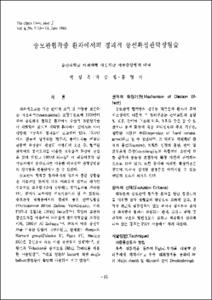한국 정신 역동학실제의 현황 분석
- Alternative Title
- The Current Status of Psychodynamic Formulation in Korea
- Abstract
- This study was intended to get the base-line data of psychodynamic formulation for teaching the residents through the analysis of the current status of psychodynamic formulation in Korea.
Data were collected through the mailings-questionnaire survey. Subjects served for this study consisted of 1,034 psychiatrists including 259 residents and 775 psychiatric specialists in Korea, using census method.
Statistical method employed was percentage rate.
1. 267 respondents(25.8%) among 1,034 psychiatrists replied to our mailings questionnaire.
2. 83.5 percent of respondents perceived psychodynamic formulation to be very important, 46.8 percent of respondents felt formulation to be crucial for second year residents, while 37.8 percent of respondents stated that they referred to textbooks of psychiatry, others(25.1 percent) sent guidelines for the mental status examination and/or descriptions of the intake interview.
5.6 percent of respondents did not provide any materials for psychodynamic formulation.
2 percent of respondents did not answer this question. 55.4 percent of respondents recognized general psychiatry, psychopharmacology and biological psychiatry to be more important than the teaching of formulation.
As a result, though the Korean psychiatrists recognized formulation to be very important, they did not sufficiently provide the materials about psychodynamic formulation.
3. the Korean psychiatrists prefered to psychoanalysis models, focal psychodynamic approaches and/or biopsychosocial approaches in case of formulating the psychiatric patients, while the American psychiatrists tended to adapt psychoanalysis and/or ego psychological models to their patients.
4. 72.7 percent of respondents indicated that they distinguished psychodynamic formulation and diagnostic assessment, while 20.9% of respondents emphasized that all patients require a diagnostic assessment. 48.7 percent of respondents viewed that psychodynamic tended to be overlooked and declined due to recent advanced biological psychiatry.
This study was intended to get the base-line data of psychodynamic formulation for teaching the residents through the analysis of the current status of psychodynamic formulation in Korea.
Data were collected through the mailings-questionnaire survey. Subjects served for this study consisted of 1,034 psychiatrists including 259 residents and 775 psychiatric specialists in Korea, using census method.
Statistical method employed was percentage rate.
1. 267 respondents(25.8%) among 1,034 psychiatrists replied to our mailings questionnaire.
2. 83.5 percent of respondents perceived psychodynamic formulation to be very important, 46.8 percent of respondents felt formulation to be crucial for second year residents, while 37.8 percent of respondents stated that they referred to textbooks of psychiatry, others(25.1 percent) sent guidelines for the mental status examination and/or descriptions of the intake interview.
5.6 percent of respondents did not provide any materials for psychodynamic formulation.
2 percent of respondents did not answer this question. 55.4 percent of respondents recognized general psychiatry, psychopharmacology and biological psychiatry to be more important than the teaching of formulation.
As a result, though the Korean psychiatrists recognized formulation to be very important, they did not sufficiently provide the materials about psychodynamic formulation.
3. the Korean psychiatrists prefered to psychoanalysis models, focal psychodynamic approaches and/or biopsychosocial approaches in case of formulating the psychiatric patients, while the American psychiatrists tended to adapt psychoanalysis and/or ego psychological models to their patients.
4. 72.7 percent of respondents indicated that they distinguished psychodynamic formulation and diagnostic assessment, while 20.9% of respondents emphasized that all patients require a diagnostic assessment. 48.7 percent of respondents viewed that psychodynamic tended to be overlooked and declined due to recent advanced biological psychiatry.
- Issued Date
- 1993
- Type
- Research Laboratory
- Alternative Author(s)
- Kim,Hun-Soo; Kim,Hyun-Sil; Min,Byung-Kun
- Publisher
- 울산의대학술지
- Language
- kor
- Rights
- 울산대학교 저작물은 저작권에 의해 보호받습니다.
- Citation Volume
- 2
- Citation Number
- 1
- Citation Start Page
- 44
- Citation End Page
- 53
- Appears in Collections:
- Research Laboratory > The ULSAN university medical journal
- 파일 목록
-
-
Download
 000002024370.pdf
기타 데이터 / 241.5 kB / Adobe PDF
000002024370.pdf
기타 데이터 / 241.5 kB / Adobe PDF
-
Items in Repository are protected by copyright, with all rights reserved, unless otherwise indicated.